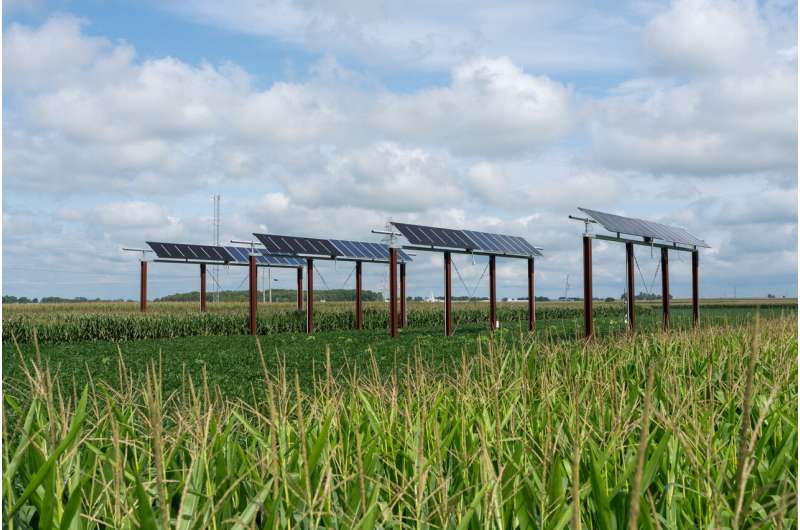This article has been reviewed according to Science X's editorial process and policies. Editors have highlighted the following attributes while ensuring the content's credibility:
fact-checked
trusted source
proofread
Validated simulations optimize solar power generation with row-crop agriculture

A Purdue University research team has demonstrated how to optimize yield in corn fields equipped with solar power arrays that throughout the day cast dynamic shadows across growing crops.
The team of eight researchers from Purdue University and Aarhus University in Denmark published their findings July 26, 2024, in Cell Reports Sustainability.
Solar panel arrays—photovoltaics—normally cast permanent shadows on the ground throughout the day. Permanent shadow on a farm field would harm crop growth. The Purdue team tested an agrivoltaics system that towers high above the crops to permit combine harvester operations.
The system tracked the sun during daylight hours. With constantly moving panels, every corn row received different light intensities throughout the day, but none sat under steady shadow.
"We developed a model to calculate what fraction of light is falling on each row," said co-author Rakesh Agrawal, the Winthrop E. Stone Distinguished Professor of Chemical Engineering at Purdue.
Armed with the Purdue team's working plant growth and light intensity (dynamic shadow) models, researchers now can ask critical what-if questions. What if the solar panels operated at lower heights? What if they were brought closer together, or farther away from each other? And what if they grew a shorter variety of corn?
"One season is one data point. If you want to change your variables, there's only one summer every year, so if we change the height, you can grow only one crop that year to measure the impact," Agrawal said. But with the simulations, photovoltaics manufacturers, power companies and farmers alike can ask several what-if questions and quickly test multiple options.
The panels in the Purdue experiment stood 20 feet high. But the modeling has already shown that panels 10 feet high would produce similar results with much lower construction costs.
"We are showing the world that, for corn, such a thing can be done and it works very well," Agrawal said.
Co-author Margaret Gitau, professor of agricultural and biological engineering, noted that in some situations, agrivoltaics can also affect field microclimate in ways that promote the climate resilience of crops.
"Some areas could experience wetter, cooler conditions, while in other areas, conditions might be no different than in areas without solar panels," Gitau said. "Shading provided by the panels can be important in conserving moisture in areas that experience water and temperature stress during particularly dry periods."
Agrivoltaics also offer the potential to build self-sustaining water systems. Runoff or drainage waters could be collected and recycled to provide supplemental irrigation using power generated on-site, she said.
Most U.S. agrivoltaics work focuses on specialty crops such as Brussels sprouts, raspberries, cabbages and peppers. But those crops occupy a small land percentage when compared to row crops.
In 2022, corn, soybeans and wheat encompassed more than 200 million acres in the U.S., according to the Food and Agriculture Organization of the United Nations.
"The opportunity at scale is big," Mitch Tuinstra, who holds the Wickersham Chair of Excellence in Agricultural Research, said, even when considering the specific needs of agrivoltaics systems, including nearby transmission lines, level ground and moisture limitations.
The lead author of the interdisciplinary study, Ph.D. student Varsha Gupta, is jointly advised by Agrawal and Gitau. "Varsha has been well able to integrate knowledge across various disciplines, including chemical engineering, data science, artificial intelligence, mathematics, and agricultural and biological engineering, which is no easy feat," Gitau said.
The new paper follows a related study published last March by six of the same co-authors that described how to optimize agrivoltaics systems for food or energy production by adjusting solar tracking or antitracking.
Tracking all the time generates the most energy. Antitracking casts no shadow on crops but also generates no power. The new study reports how to optimize the system with dynamic shadow modeling.
The experimental results published in both papers revealed a relatively small impact of dynamic shadows on corn yield from agrivoltaics. The data sets were somewhat different, yet the corn in both experiments experienced shading from 20% to 25% of the time.
"You'd think there would be a 20% to 25% loss. We're seeing about 8% loss," Tuinstra said.
Farmers can make $1,000 an acre from power production if they optimize for energy, and about $300 an acre if they optimize for corn. Tuinstra envisions a day when a smart system connected to the Chicago Board of Trade could dynamically account for corn and energy market prices.
"Opportunities in agrivoltaics and renewable energy production may also contribute to future ecosystem services," the benefits that ecosystems provide to people, Tuinstra said. This becomes possible if new sustainable and regenerative agricultural technologies can be integrated with agrivoltaics.
Regenerative agriculture encompasses management strategies that include cover crops, strips of prairie, no-till farming and minimal application of nitrogen fertilizer. Such practices offer ecosystem services, but their costs are steep for consumers, growers and the government alike.
"If you figure out a way to integrate these things, all of a sudden, you have ecosystem services that are paid for by renewable energy. Everybody can benefit from these ecosystem services," Tuinstra said.
More information: Varsha Gupta et al, Optimizing corn agrivoltaic farming through farm-scale experimentation and modeling, Cell Reports Sustainability (2024). DOI: 10.1016/j.crsus.2024.100148


















